While he’s not busy with his day job working on hydronic heating systems, commercial and residential plumbing, backflow prevention and gas work, Chris Massaro (@nwo_plumber) loves playing guitar and recording music. Admiring the recent tattoo to commemorate his daughter’s birth, “I was in a bunch of bands throughout high school and recorded an album once Read more
Featured Articles
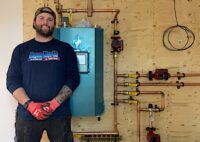
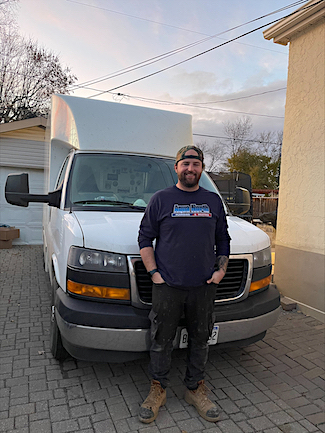 While he’s not busy with his day job working on hydronic heating systems, commercial and residential plumbing, backflow prevention and gas work, Chris Massaro (@nwo_plumber) loves playing guitar and recording music. Admiring the recent tattoo to commemorate his daughter’s birth, “I was in a bunch of bands throughout high school and recorded an album once. I don’t get around to it as much as I used to or like to, but I’m definitely making more time for that now,” says Massaro, owner/lead tech at Aqua North Plumbing and Heating Ltd., Thunder Bay, Ontario, Canada.
While he’s not busy with his day job working on hydronic heating systems, commercial and residential plumbing, backflow prevention and gas work, Chris Massaro (@nwo_plumber) loves playing guitar and recording music. Admiring the recent tattoo to commemorate his daughter’s birth, “I was in a bunch of bands throughout high school and recorded an album once. I don’t get around to it as much as I used to or like to, but I’m definitely making more time for that now,” says Massaro, owner/lead tech at Aqua North Plumbing and Heating Ltd., Thunder Bay, Ontario, Canada.
I take that back. Massaro also enjoys hanging out with friends and family, golfing and mountain biking. And, he definitely needs to get that grill time in—grill, smoke, BBQ. “Sometimes in that order, in one cook. Most of the time I do use the smoker though. I’ve been on a pulled pork kick lately. My favorite is some nice pork shoulders on the Traeger. It’s the ultimate dad activity, in my opinion,” says Massaro.
The work\life balance has been a struggle for Massaro; he realized one day that when you are running your own small business sometimes there isn’t a balance. You have to make the time and prioritize it. “Do what’s important to you and make time for the people and activities you love. And most importantly, take care of yourself! Because you’re worth it. Time stands still for no one so spend it wisely,” says Massaro.
 And that’s why staying physically fit and active is important to Massaro. “I’m always lifting, bending, up and down the stairs all day so it’s helpful to have a training regimen that supports that. And, it really helps to keep me in mental shape as well,” say Massaro.
And that’s why staying physically fit and active is important to Massaro. “I’m always lifting, bending, up and down the stairs all day so it’s helpful to have a training regimen that supports that. And, it really helps to keep me in mental shape as well,” say Massaro.
Even more important is eating right, says Massaro. “We use a lot of energy in a day in the trades so we have to keep that fire fed. All of this allows me to stay energized all day and still have plenty of gas in the tank when I get home for family time,” continues Massaro.
Massaro’s foray into the trades started when he starting working for the family business as a plumbing apprentice at the age of 13. “Made best friends with my shovel and we went to work. Thankfully, I graduated from digging trenches and went on to start really learning about the ins and outs of the trade,” recalls Massaro.
Over the next few years, Massaro spent most days plumbing residential systems with a few commercial jobs sprinkled in here and there while working for my father. “It was nice to be doing a bit of everything and not just strictly one area of the trade, which I felt was important to be a well-rounded tech.
Once Massaro had a few years under his belt, he did a lot of remote northern work for fly-in communities. “Those big jobs we did up there really sharpened my time and material management skills,” says Massaro.
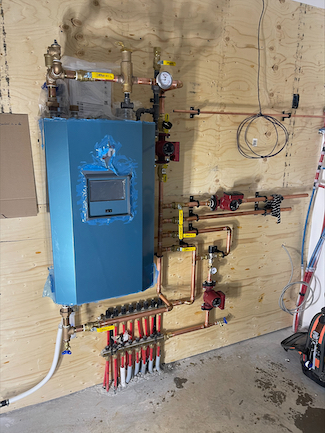 In addition, the high school Massaro attended offered a cooperative education program where he was able to gain work experience hours toward his apprenticeship if he chose to stick with plumbing. “I would go to regular classes for the morning periods then co-op at Aqua North in the afternoon,” says Massaro.
In addition, the high school Massaro attended offered a cooperative education program where he was able to gain work experience hours toward his apprenticeship if he chose to stick with plumbing. “I would go to regular classes for the morning periods then co-op at Aqua North in the afternoon,” says Massaro.
As a side note, Massaro says that if your local high school offers a cooperative education program, he highly recommends getting involved. “It’s a really pressure-free way to get your feet wet in whatever trades the school offers,” says Massaro. “I always try to take on one co-op student per year and leave them with a positive experience in the trade. I feel that’s the best way for kids to feel out what they want to do. And, don’t be afraid to ask questions!”
Next, after getting all of his trade school and work hours complete, Massaro then wrote his exam for his certificate of qualification in plumbing. Shortly thereafter, Massaro bought the family business, and the rest is history.
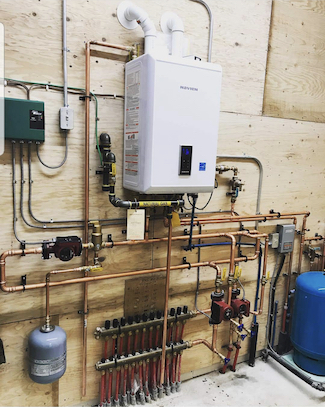 As fourth-generation plumber, Massaro has had some great mentors in his career, with plenty of help and guidance from his father and grandfather in learning new and old ways of plumbing. “If my great grandfather was around then I’m sure he would have some real old school stuff to show me.”
As fourth-generation plumber, Massaro has had some great mentors in his career, with plenty of help and guidance from his father and grandfather in learning new and old ways of plumbing. “If my great grandfather was around then I’m sure he would have some real old school stuff to show me.”
And while Massaro doesn’t consider himself a role model, he’s always willing and ready to help others to do their best at work, and life in general. “I’ve learned a lot over the years and sharing the experiences and knowledge with up-and-coming tradespeople is paramount,” says Massaro.
For Massaro, he loves building something from nothing and executing the job. “Sometimes just sitting back after the job is done and being like ‘damn we really did that.’”
Perception Change
The perception of the industry needs to change, says Massaro. “I think the wheels are turning on that as we speak but we’ve got a long way to go.”
 Social media is that vehicle for the instrument of change as it’s an easy way to showcase contractor work, and connect with other professionals. “There’s a solid amount of tradespeople out there doing an amazing job. If we can show people that there’s more to plumbing than just plunging toilets, fixing leaks, and back-breaking work, then I think that’s a win,” says Massaro.
Social media is that vehicle for the instrument of change as it’s an easy way to showcase contractor work, and connect with other professionals. “There’s a solid amount of tradespeople out there doing an amazing job. If we can show people that there’s more to plumbing than just plunging toilets, fixing leaks, and back-breaking work, then I think that’s a win,” says Massaro.
Whether it’s new and better tools, techniques, business knowledge, etc., Massaro has learned so much on social media. “It’s awesome that we can connect with people and have such a great community sharing tricks of the trade, meet-ups or even debate if it’s tape then dope—which it is—or dope then tape,” says Massaro.
In the end, as Massaro sets his sights on his career and further enriching his life, a good bucket list item to check off would be getting a recreational pilot’s license. “Always wanted to get into aviation in some way.”
The sky’s the limit.
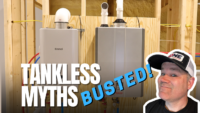
https://youtu.be/ZSDNnJmsl78 After nearly 25 years in the plumbing & heating industry I can say with confidence I’ve heard just about all there is to say about tankless, right or wrong…most of it wrong! In this video I go over 8 separate myths that are commonly said about tankless. With each myth I give facts and Read more
After nearly 25 years in the plumbing & heating industry I can say with confidence I’ve heard just about all there is to say about tankless, right or wrong…most of it wrong!
In this video I go over 8 separate myths that are commonly said about tankless. With each myth I give facts and opinions based on my experience that bust every myth.
If you’d like more information about tankless check out Rinnai US
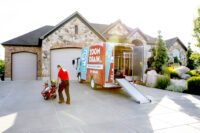
At the foundation of the plumbing industry is a home service built on legacy, featuring businesses that have been passed down from one generation to the next. Sometimes, this can create unforeseen challenges, and perhaps the most common issue relates to succession. We all want the best for our business but problems can sometimes arise Read more
At the foundation of the plumbing industry is a home service built on legacy, featuring businesses that have been passed down from one generation to the next. Sometimes, this can create unforeseen challenges, and perhaps the most common issue relates to succession.
We all want the best for our business but problems can sometimes arise when allocating portions to the next in line, who then look to do the same thing with their children when the time comes. But when dividing up the business, it can dilute the overall brand, no longer making it sustainable. Instead of splitting up and weakening it, why not bolster it and create an even stronger legacy? That’s where franchising can be so valuable to a generational plumbing business.
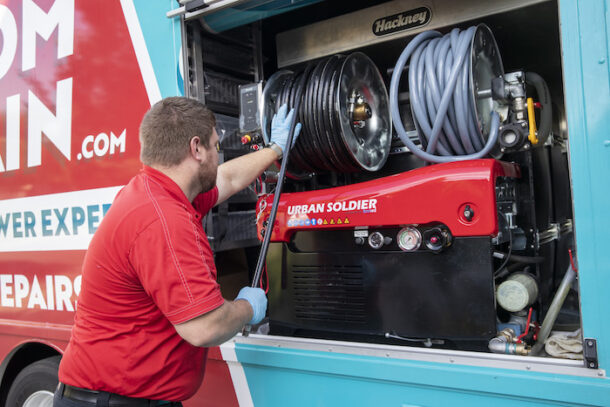
A Zoom Drain franchise may be a great opportunity for you to expand your business empire. Some of our franchisees own and operate PHC companies and have added a Zoom Drain franchise as a “plus play” company—a separate business that complements their existing service business. This is something that the Philadelphia-based company has spent years perfecting, creating an enticing opportunity to plumbing businesses and a great subsect that allows for consistent growth and development.
Specializing in drains and sewers, if it deals with wastewater, we deal with it—everything from sewer video inspections to drain cleaning and grease trap maintenance. And with almost three decades worth of experience, we’ve carefully crafted a model to consistently grow franchises.
For one Zoom Drain franchisee, working with his father—an experienced plumber—had long been on his mind. The concern was that bringing the “Son of the Boss” into the existing plumbing business at a management level would be upsetting, and potentially unfair, to the team that was already in place. Instead of “dividing the farm,” they decided to add a Zoom Drain franchise. This would support a succession plan and help them expand their business holding. Since then, both companies have grown. They refer work, from one company to the other, and find economies of scale by coordinating administrative and operational activities.
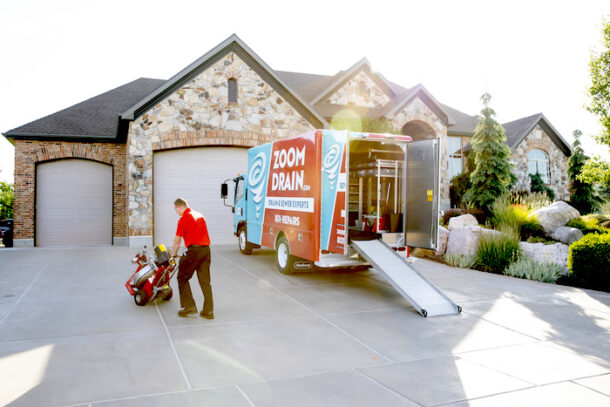
So, what is the model? At its core, it comes down to just three simple words: calls, techs, trucks. Here’s a little look at what exactly goes into our secret sauce.
- Zoom Drain has dialed in their marketing processes. Focusing on highest Lifetime Value Customers, the exclusive 40 Steps Program ramps up calls fast, so that franchisees can open with a solid stream of referral leads.
- Recruiting, orientation and training the right people is so important and, with a proven process that includes comprehensive in-house training, you can morph a novice into a successful drain pro in months, not years.
- Because we only do drain and sewer work, the technicians have the tools and gear they need to solve most drain problems. Our super service trucks have the Zoom Jetting system built right in.
Now, with the addition of 10 franchises already in 2022, new franchisees are already seeing the benefits of this niche business.
“I was presented with four different franchise opportunities and, in my head, I said there’s no way I would do Zoom Drain—I don’t want to do that, that’s not in my wheelhouse,” admitted Kevin Hussey, of soon-to-open Zoom Drain of Northwest New Jersey. “And then I got to meet the people—I have never been disappointed or let down by any of them, so that’s the draw!”
One common misconception with franchising is that there’s a lack of support – that you’re on an island 500 miles away and you’re left to just figure things out on your own. Zoom Drain isn’t just going to hand the ball off after your franchise launches. All of that extensive pre-launch support continues, through planning and operational manuals, with detailed projects and how to execute them—plus simple, yet powerful, financial systems that guide you through key metrics.
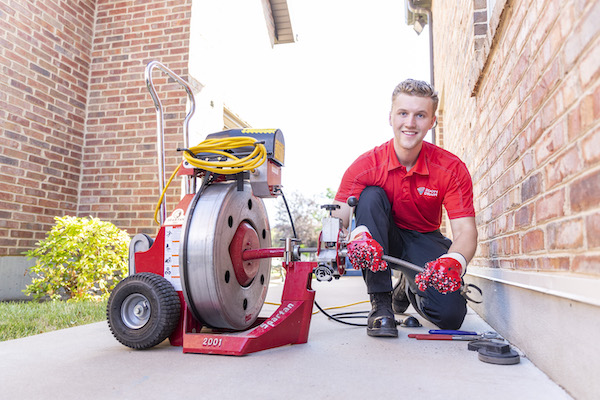
“I just love the fact that Zoom Drain is very franchise friendly, in terms of providing support from the beginning to the end. Just the support they provide in terms of onboarding, the systems and the processes they have in place. As a new franchisee, I don’t have to figure it out for myself,” said Will Clay, who just recently opened Zoom Drain of Atlanta earlier this summer.
“Everybody I met, it was like, ‘OK, Zoom Drain wants us to be successful just as much as we want to be successful,’” said Robert Pace of Zoom Drain Collin County. “And I felt like they were honest and genuine, that they weren’t just giving us lip service and saying that this is what we’re going to do to get us in the door to sell a franchise—to put a dot on the map. They were really interested in bringing people in, showing them the business and helping them be successful.”

Domestic Water’s Creepy Challenge It’s a, well, creepy sort of problem. That is, when hot water recircs lose their ability to govern themselves. So, there’s the problem. But, let’s back up just a bit. Let’s start with an explanation. Then we’ll talk to the experts. There’s little debate that residential or light commercial domestic hot Read more
Domestic Water’s Creepy Challenge
It’s a, well, creepy sort of problem. That is, when hot water recircs lose their ability to govern themselves. So, there’s the problem.
But, let’s back up just a bit. Let’s start with an explanation. Then we’ll talk to the experts.
There’s little debate that residential or light commercial domestic hot water recirculation (DHWR) technology has proven its value in the world of plumbing and mechanical systems. The devices guard our safety, comfort and health. Hot water recirc systems move potable hot water to fixtures quickly, without waiting for the water to get hot, so there’s less wasted water, and time.
The key challenge to these simple systems is the problem of “hot water creep.” Let’s take a closer look, beginning with an examination of the components that have a role in the recirculation of a home’s domestic hot water.
Let’s first define the “system” After all, the various components, if not connected intelligently and working in concert, would accomplish nothing:
- Water heater without a tempering/mixing valve. Essentially, an unprotected, full-on arrangement that places anyone at risk.
- Water heater with a distribution tempering/mixing valve (typically, and ASSE 1017, or ASSE 1070 valve). This is most common, and became the point of introduction for DHWR systems.
- Water heater with distribution tempering/mixing valve with a DHW recirculation pump and a bypass valve or pump located at the domestic water system’s most remote fixture – with use of the cold water line as a means of returning water to the water heater.
- Water heater with distribution tempering/mixing valve with a DHW recirculation pump and a dedicated return line from the most remote fixture on that particular hot water zone. Ideally, this is how a DHWR system is installed.
- Finally, all of the above, to include a control of some means; aquastat, timer or combination control with some kind of logic.
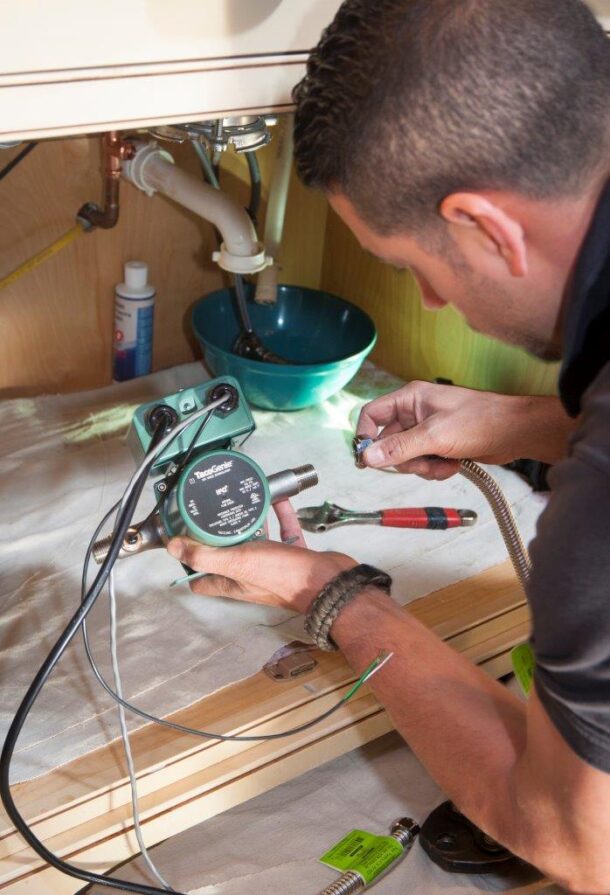
“It takes some, or several of the components above, to make a DHWR system,” explained Rick Mayo, product and applications instructor, Western region, Taco Comfort Solutions.
Most recirc systems, by design, have a tempering valve that continuously adjusts its temperature when water flows through it – while tempering (that is, mixing) it with cold water – to maintain proper outlet water temperature for rapid release at points of use.
The challenge is to maintain the mixed water temp during periods of no demand. The reason for this: the recirc’s pump enables flow through the valve, even when there’s no demand, or draw, from points of use – such as faucets and other fixtures. For this reason, recirc pumps must be piped so that the recirc’s returning flow can reach both the cold connection of the valve as well as the cold connection of the heat source. Some balancing may be required.
Smart, by design
Typically, a water heater’s storage temperature is set for about 140°F for legionella mitigation, and the DHWR’s hot water temperature is reduced to under 120°F at the mixed outlet connection of the valve (with the reduced temp made possible by mixing with cold water, by design).
This cause the valve assembly to adjust temperature; that is, until it reaches the hot water’s set-temp. The internal thermostat adjusts the piston to open the cold port and close the hot port, allowing hot water to recirculate. Unfortunately, there can be challenges to the intended function of these systems.
- Creepy situation #1: If the hot water distribution system isn’t insulated, this can cause the distribution loop temperature to creep down during periods of no demand.
- Creepy situation #2: Domestic water systems installed with a domestic hot water recirculation pump may cause downstream water to overheat if it’s not piped properly or is running longer than required. This overheating of temps within the piped system may go unnoticed for quite a while and could cause risk of scalding at points of use.
Mayo offers this insight: The ASSE 1070 valve does a better job of restricting flow of the hot water than the ASSE 1017 and is more effective at preventing “creep.” He clarifies: “Don’t get me wrong. Those ASSE 1017 valves work as intended in non-recirc systems. If the temperature is set for 115°F, they regulate the temperature to that point, almost assuredly. But as soon as you match ‘em up with a (DHW) recirc, problems can begin.”
- Creepy situation #3: Make sure there’s always sufficient flow to meet the DHWR valve’s minimum flow requirement. All DHWR control valves need a certain amount of flow to function properly. A properly sized, recirc pump will usually assure sufficient flow.
- Creepy situation #4: A point-of-distribution, ASSE 1017 mixing valve (or, for that matter, even the ASSE 1070 valve) that does not have a full or completely closed function for its hot inlet port can cause thermal creep if not properly piped and controlled; many mixing valves with an electronic actuator have a fully-closed position so that this doesn’t occur.

Piped conundrum
“It’s often a piping challenge,” said tekmar’s General Manager, Greg Leupin. “For many hot water recirc ‘creep’ challenges, the challenge has to do with incorrect piping. When the recirc is off or at rest, thermal ‘ghost flow’ can affect the amount of hot water that makes its way into the [distribution] piping.
Leupin added that many recirc loops lack a mixing valve, causing excessive – sometimes unsafe – temperature in the recirc loop, increasing the risk of scalding. This can also lead to inefficiency from heat loss, especially when the domestic water lines aren’t insulated.
Smart technology
Manufacturers have stepped in to help negate the risk of domestic water creep when recirc systems are installed. “Installation instructions are more explicit and the technology’s improved,” said Mayo.
“The problem begins when there’s an inability to dissipate the heat during periods of no demand,” added Mayo. “As referenced earlier Some [DHWR] devices close the hot side better than others, so both the built-in control strategy may help, as does the installation piping. Of course, the recirc shouldn’t be running when the distribution system’s already sufficiently full of hot water, readily accessible at taps and other points of use.”
- Taco SmartPlug (which won AHR Expo’s Product of the Year Award in 2017) was developed to eliminate the hassle of a “timer;” because of their design they only allow water to be circulated for short periods of time, this can help fight the challenge of thermal creep. The small device instantly changes any corded hot water recirc – for instance, those with just timer and on/off function – into a “smart” device by giving it the intelligence it needs to learn a household’s usage patterns to improve and regulate hot water distribution, increasing comfort and efficiency. It can also be set into a ‘pulse only’ mode for light commercial applications, or for homeowners who don’t have a predictable schedule.

Other hot water recirc solutions include:
- TacoGenie allows homeowners to simply push a button when hot water is desired at a tap, on demand.
- Watts/Premier 500800 – an ideal solution for retrofitting existing domestic water systems with hot water recirc. The device uses the pump at the water heater (though not tankless systems) and an under-sink sensor valve to create a pressure differential – allowing the cold and cool water in the hot water supply line to bypass into the cold water supply line at a low volume through the thermostatically-controlled sensor valve, keeping the water in the hot water supply line at a “no-wait” temperature throughout the home.
ASSE 1070 valve
As Mayo stated earlier, ASSE 1017 thermostatic valves installed at the water heater or heat source may not close off sufficiently in some instances (while the circulator is running) to stop the outward flow of heat. If this happens, and a recirc pump continues to run, temperatures within the distribution piping can creep upward – creating the potential for unexpectedly hot water at taps.
In a situation like that one, the need for hot water [in the distribution piping] is satisfied, but if the [DHWR] pump’s running, ‘creep’ can occur,” concluded Mayo. “Yet another solution protects users from unexpectedly high temps at the tap with or without replacement of the distribution safety valve – and that is the installation of 1016 or 1070 point-of-use valves. They’re most often used for commercial installations, though there are many residential uses of the valves.”
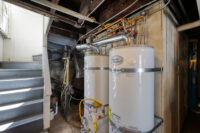
Decoupling Boiler and Installing Water Heaters in Century-Old San Francisco Apartment House Brings Relief to Residents Nothing lasts forever. That is especially true with mechanical fixtures, where the corrosive nature of water, the environment in which units are located and frequent use all work against fixture longevity. Nearly a century of service isn’t forever, but Read more
Decoupling Boiler and Installing Water Heaters in Century-Old San Francisco Apartment House Brings Relief to Residents
Nothing lasts forever. That is especially true with mechanical fixtures, where the corrosive nature of water, the environment in which units are located and frequent use all work against fixture longevity.
Nearly a century of service isn’t forever, but it’s a pretty good run. Some steam boilers, especially in inner-city buildings, that were installed in the 1920s and ‘30s are still in service. The reliance on steam-heated buildings in that era was a “direct result of theories of infection control” to help fight the global pandemic of 1918 and 1919, according to a Bloomberg article in 2020. Masks, shots and forced isolation fought against the most recent pandemic, but a century earlier the solution was far simpler – open the windows.
The theory followed the correct premise that fresh air would help fight off airborne diseases. In New York City, for instance, the Board of Health ordered windows to remain open to provide ventilation – even in winter. Steam heating and radiators thus packed plenty of punch. They provided heat for building residents on the coldest days and with windows open. Efficiency, obviously, was not top of mind when the boilers were installed.
In San Francisco, Excalibur Water Heaters solved a heating issue for an 8-bedroom apartment house that relied on a steam boiler that been in place since the building opened in the 1930s. The steam boiler provided hot water and radiant heat. “Because of the age of the boiler, the hot water was never reliable,’’ said Anthony Achermann, one of the owners of Excalibur.
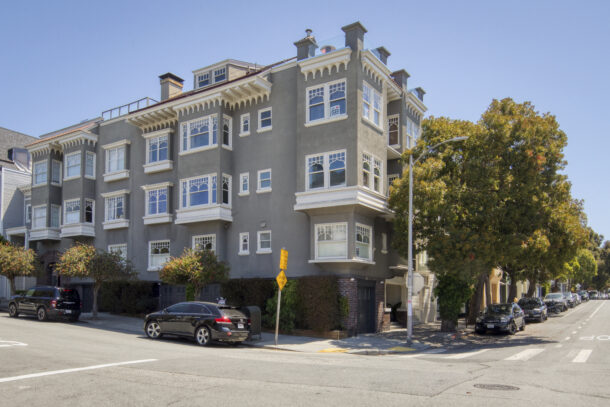
An 8-unit apartment house in San Francisco solved a problem with hot water delivery by installing two American Standard Water Heaters to replace an aging and faltering boiler.
Excalibur designed a solution that solved the problem in just one workday. The company installed two American Standard Water Heaters to provide hot water to the building. Due to space limitations, Achermann’s team used two 50-gallon tanks instead of one 100-gallon tank. Even more interesting, the ancient boiler remained in place and will remain the heating source for the apartment house.
A Hot Mess
The simple solution would have been to repair the ancient boiler – again – or install a new one. Achermann knew neither would be terrific options.
Replacing the steam boiler would have required a lengthy wait due to supply chain issues. The boiler had been repaired and serviced frequently, but few products that are nearly 100 years old work like they did when they came out of the box. In addition, many repair technicians avoid a challenging boiler replacement project.
“Most plumbers in this industry when they see a boiler, they run,’’ Achermann said. “Boiler service people are few and far between these days. Retrofitting any building with a boiler is hard.”
The boiler – “about the size of MINI Cooper,” Achermann said — operated on a timer, so hot water availability differed throughout the day. “Sometimes hot water was readily available,’’ Achermann said. “Other times it was lukewarm or no hot water.”
Steam boilers undergo significant stress and age over time. Poor water chemistry, corrosion, extreme temperature shifts and even the environment where the boiler is installed can contribute to the degradation of a unit.
Caustic embrittlement due to corrosion is a serious form of boiler metal failure. Even worse, chemical attack of the metal is usually undetectable. Failure occurs suddenly, often with catastrophic results. While aging, the apartment house boiler still has enough juice to provide heat. Perhaps it will need to be replaced at some point, but for now it serves the building. Certainly, the building owner can hardly quibble after receiving a lengthy amount of service from the heating beast.
The project was part of a remodeling of the apartment house. “The steam boiler was as old as the building,’’ Achermann said. “If they wanted to replace the boiler, they would have had to wait weeks, if not months. It was a common problem, but I’m seeing it less and less. When I come into a situation like this, I try to identify an out-of-the-box solution that can solve the problem.”
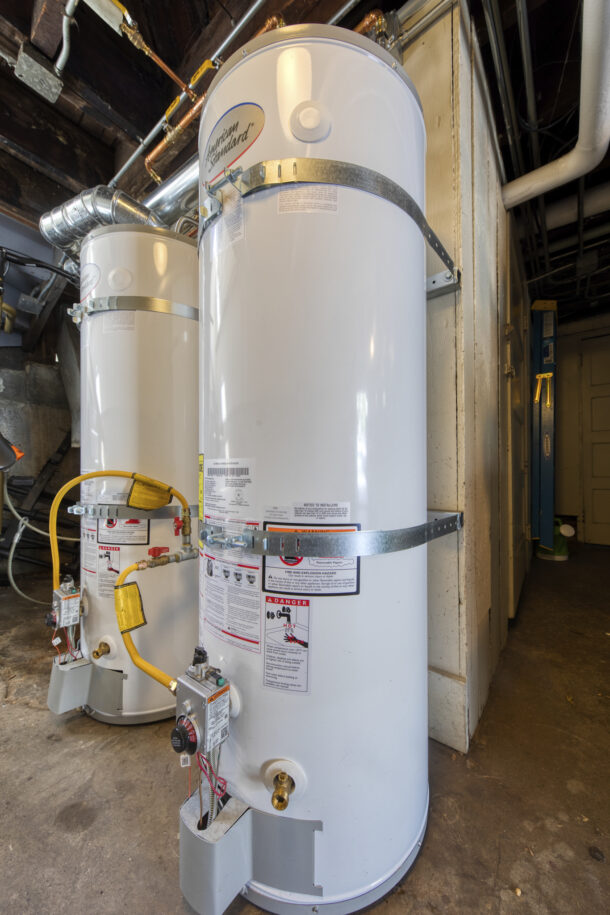
Due to the tight footprint of the mechanical room, Excalibur Water Heaters installed two 50-gallon tanks instead of one 100-gallon tank.
Splitting Service
Achermann solved the issue by decoupling the boiler from providing hot water. The in-place boiler still runs the heating system for the apartment house, but his team installed two American Standard Water Heaters for the building’s hot water service.
Because of space issues, Excalibur installed two 50-gallon tanks. “We didn’t have the space or the height clearance to install a 100-gallon tank,’’ Achermann said. “It was a pretty tight fit.”
The durability of the American Standard Water Heater brand was important to their inclusion in the project. “Over the years, water heaters have been getting lighter, they are making the walls on many brands thinner,’’ Achermann said. “Over time, water will try to corrode the tank. Anode rods are supposed to prevent that, but eventually they’ll leak and fall apart. The water doesn’t have anywhere to go, and it leads to leaks. By having a heavier tank, it’s buying more time.”
One of the most dangerous tasks for the project involved separating the boiler and installing the water heaters. With the gas and water lines coming into the building, the team took extreme care to complete a smooth transition.
“It’s important to understand the severity of what could happen if something goes awry,’’ Achermann said. “If something goes wrong, it could create a pressurized vessel that can cause an explosion. We had to make sure the steam radiators work appropriately, and that the boiler only has to make the steam.”
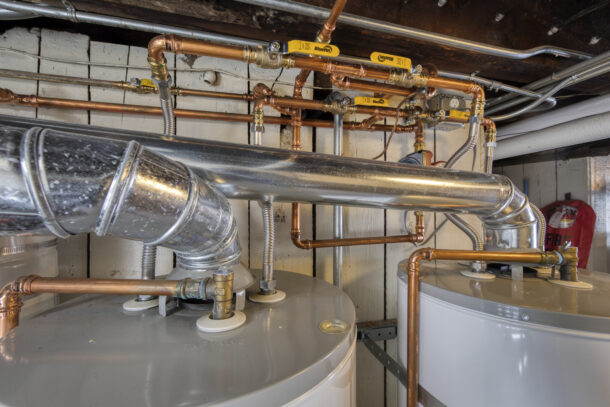
Additional Benefits
The warranty and burner assembly on the American Standard Water Heaters also factored into the selection for the project, Achermann said.
“With many manufacturers, the water heaters just make it past the warranty,’’ Achermann said. “The American Standard Water Heaters last well past their warranty date. They are also the only manufacturer in the San Francisco area that uses a mechanical gas control valve.”
The gas control valve is a traditional assembly that has served the industry well for decades. Many newer models have electronic assemblies that break down far earlier. “The electronic ones are harder to repair, while the mechanical heaters are much more robust overall,’’ he said. “I was getting tired of explaining why a unit we installed two years ago was failing.”
Workers completed the 10-hour project safely, and tenants celebrated that consistent hot water would flow to their apartments without interruption. “They’re excited because they now have consistent hot water,’’ Achermann added. “Sometimes it would take 3-4 minutes. We installed a recirculation pump and now the water gets hot within seconds.”
Overall, the project married Excalibur’s ingenuity, durable products and working with mechanicals already in place. Sometimes plumbers don’t have to re-invent the wheel. Making a few subtle tweaks saves time, money and energy, even if the units were around during the Hoover administration.
“It was a project that required some creativity as to how we could solve the problem,’’ Achermann said. “We came up with a good concept and the owner and the tenants are happy.”
Thomas Renner writes on trade industry topics for publications throughout the United States.
